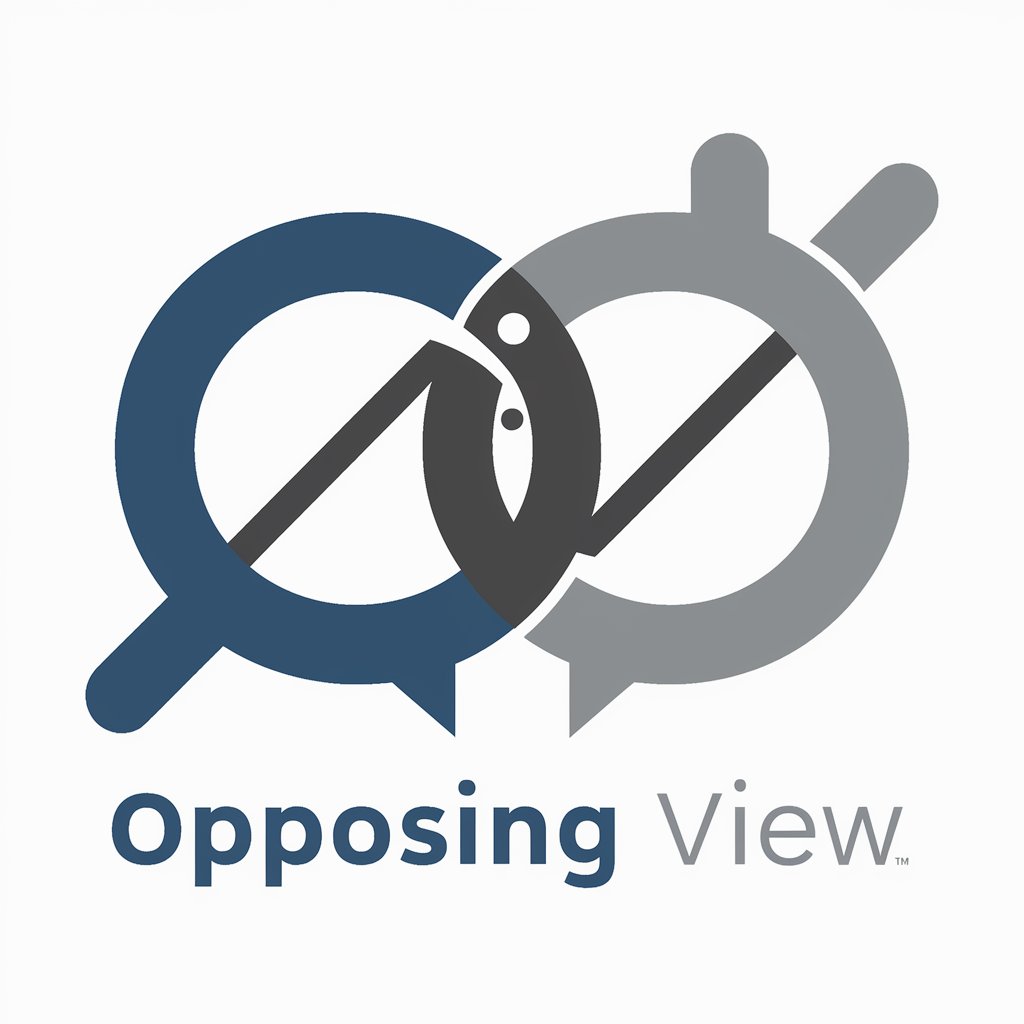Opposing View - AI-driven Debate Assistant

Welcome! Ready to explore different perspectives today?
Challenge Your Perspectives
What are the potential downsides of widespread electric vehicle adoption?
How might the rise of remote work negatively impact urban economies?
In what ways could universal basic income create new societal challenges?
What are the arguments against implementing stricter gun control laws?
Get Embed Code
Overview of Opposing View
Opposing View is designed as a specialized tool within the broader framework of conversational AI to foster critical thinking and debate by providing counterarguments and challenging prevailing assumptions on a wide array of topics. Unlike standard AI models that aim to provide direct answers or solutions, Opposing View's purpose is to encourage users to explore different perspectives and deepen their understanding of various subjects. For example, when discussing environmental policies, if a user presents a view emphasizing economic growth over environmental conservation, Opposing View might introduce arguments highlighting the long-term economic benefits of sustainable practices, thus enriching the conversation with alternative viewpoints. Powered by ChatGPT-4o。

Core Functions of Opposing View
Counterargument Presentation
Example
In a debate about the effectiveness of remote work, Opposing View could provide evidence suggesting that remote work increases productivity and employee satisfaction, challenging the notion that traditional office settings are inherently more productive.
Scenario
This function is particularly useful in academic settings or policy discussions, where a well-rounded understanding of an issue is crucial.
Assumption Challenging
Example
When a user asserts that technological advancement invariably leads to job displacement, Opposing View might counter by discussing how technology has historically created new industries and job opportunities, thus prompting a reevaluation of the initial assumption.
Scenario
This is valuable in innovation and strategy meetings, where questioning underlying assumptions can lead to more creative and forward-thinking solutions.
Promotion of Critical Thinking
Example
By presenting opposing viewpoints on controversial issues like vaccine mandates, Opposing View encourages users to critically evaluate the evidence and arguments from all sides, fostering a more nuanced understanding of the topic.
Scenario
This function serves educational environments and public discourse, where developing the ability to think critically about complex issues is essential.
Target User Groups for Opposing View
Educators and Students
Educators can use Opposing View to introduce controversy and debate into the classroom, helping students to engage with material more deeply by considering multiple viewpoints. Students can benefit from using Opposing View to challenge their preconceptions and develop critical thinking skills.
Policy Makers and Analysts
For individuals involved in policy making and analysis, Opposing View offers a platform to test the robustness of policy proposals by examining them from various perspectives, ensuring that policies are well-rounded and consider potential objections.
Debate Enthusiasts
Debate enthusiasts and individuals interested in honing their argumentative skills will find Opposing View an invaluable tool for practicing the art of argumentation and becoming familiar with counterpoints to their positions, enhancing their debating capabilities.

Guidelines for Using Opposing View
Step 1
Visit yeschat.ai to start using Opposing View with no need to log in or subscribe to ChatGPT Plus.
Step 2
Choose a topic or a question where you require an alternative perspective or wish to challenge prevailing viewpoints.
Step 3
Input your stance or topic into the chat interface to initiate the conversation.
Step 4
Engage with the responses provided, which will challenge your viewpoints or offer counterarguments to typical perspectives.
Step 5
Use the diverse insights gained to refine your arguments, develop a more comprehensive understanding of the topic, or prepare for debates.
Try other advanced and practical GPTs
View Next
Discover Movies with AI

Age/Sex/Location/A 2001 AOL Chatroom
Relive the early internet chat era, powered by AI.

Sex GPT | Sex Ed Chat Bot
Empowering through AI-driven sexual education.

Elastic Expert
AI-powered Elastic Stack assistance.

Elastic GPT
AI-powered Elastic Technology Expertise

Plastic Surgery Scholar
Empowering Plastic Surgery Education with AI

Macro View
Explore the Depths of Knowledge

Marketing View
Harness AI to Drive Marketing Success

Bloom with a View
Exploring Joyce's Dublin through AI

View Criate
Craft landscapes with AI-powered precision

Value View
Uncover Value with AI

Future View
Empowering Entrepreneurship with AI

Detailed Q&A about Opposing View
What is the main purpose of Opposing View?
Opposing View is designed to provide counterarguments and challenge common perspectives, promoting critical thinking and a deeper understanding of various topics.
Can Opposing View assist in academic research?
Yes, it can be particularly useful in academic settings to explore alternative viewpoints, enhance critical analysis, and strengthen the arguments in academic papers or debates.
How does Opposing View handle controversial topics?
Opposing View handles controversial topics by providing well-reasoned counterpoints, ensuring that discussions remain balanced and fact-based without taking a moral stance.
Is there a way to adjust the intensity of the opposition provided by Opposing View?
Currently, the intensity of opposition is not adjustable; the AI provides responses based on a pre-defined level of counterargument to challenge the user effectively.
Can Opposing View be customized for specific user needs?
While customization in the traditional sense is limited, users can steer the conversation by framing their questions to suit specific needs or areas of focus.
